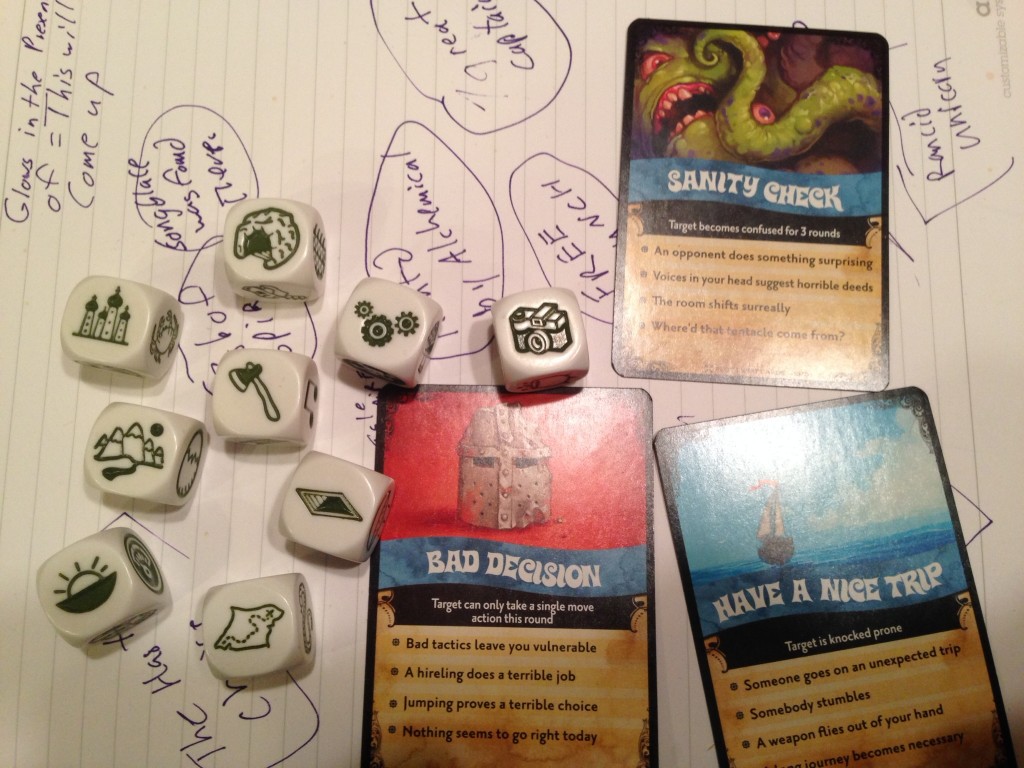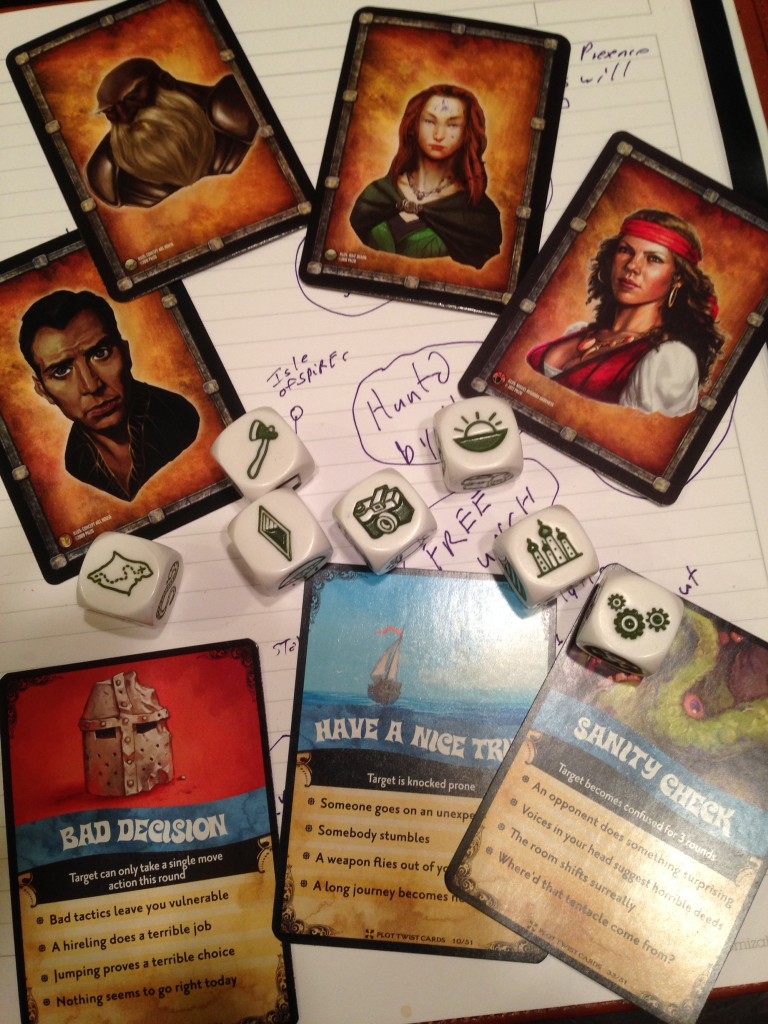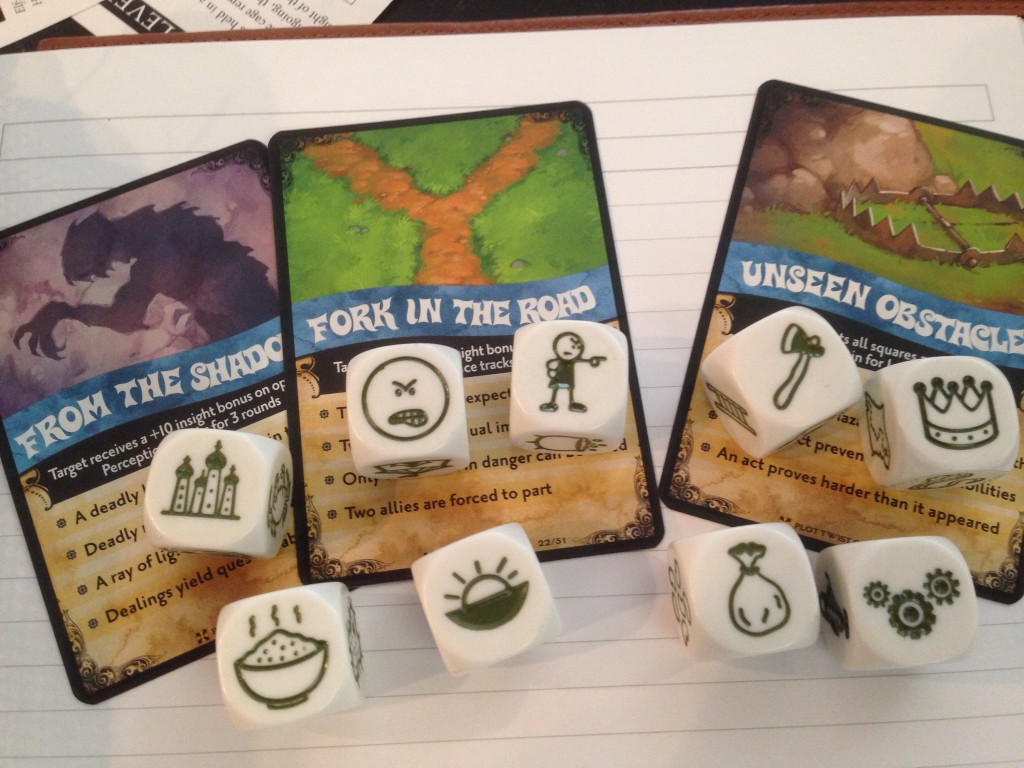Really fantastic Dungeon World session last night. 3 players (Dogan the Fighter, Sanguinus the Pirate Paladin and Lily the Bard) ended up as a pretty good number. The session went in pretty unexpected directions more than once, in very fruitful ways, and the final shape of the game was completely different than expectations going in.
We did not have the wizard, so I did not get a chance to try any magic hacks, so the jury is still out on that. What we did do is replace +1/–1 forward with a variant on the Advantage/Disadvantage rule from 5e. +1 forward became an advantage, and with advantage, the player rolled 3 dice rather than 2, and counted the two higher ones. –1 forward became a disadvantage, where the player rolls 3 dice and keeps the two lowest.
So, for example, when Sanguinus charged, it gave Dogan a +1 forward on his subsequent Hack and Slash roll (because of a Paladin ability). Normally that would mean he’d roll 2d6 + 4 (he has an 18 Strength), but in this case he rolled 3d6 and got a 2, 4 and 5. Taking the best 2 (4 and 5) he rolled a 9, plus 3 for a 12, a most palpable hit.
For the curious, the math is that an advantage or disadvantage equates to approximately +/- 1.5, so it’s a little more robust, but still in bounds. Importantly, it still keeps the result within the curve, so you get some interesting results. If you haven’t used bonus or penalty dice before this may seem weird, but for us, the experience felt really smooth. More, it made the +/–1’s simply feel a little more engaging. I’d be hard pressed to say exactly why (perhaps just the tactile component, perhaps the die making the bonus or penalty feel a little more concrete). Also, “advantage” is just nicer language than “+1 forward).We’ll absolutely be using it in the future.
I’m going to do a recap of the session, but not in the normal fashion. The plot was fine, but I’m going to use this as an opportunity to run through the details of my GM process, since I’ve been experimenting with using props to drive my play. This is going to be some serious inside baseball, so be warned.
I had no plan when we started. This is common, and is one of the reasons I chose Dungeon World. I lack the time and energy for more serious prep, so I chose DW because of how easily I can wing it. What I did know was the following:
- Dogan and Lily had just had an adventure together where they found hints of interesting things about their weapons. I could probably spin out that thread.
- The last couple adventures had all been in the city, it was time to go back out to sea. The presence of Sanguinus reinforced that.
- Lily had leveled up, and took the fighter move to make the Songblade she’d found into a signature weapon. One of the options she took was “Glows in the presence of…” . She went with “invisible enemies” but the amused observation around the table is that the real purpose of that choice is to guarantee that they show up in the game, so I had that now.
- This trio has the easiest alignment moves to engage, since they are basically fight, fight, don’t fight. That’s great once we get going, but not terribly informative for planning. And, unfortunately, the bonds between these three are similarly applicable, so they did not provide much inspiration.
- Lily’s bardic specialty is ancient heroes, so that’s an easy place to put a hook.
- The most active front at the moment is the Alchemists. And, unfortunately, most of the other fronts have been focused on the city, which is a mistake on my part. The only two naval fronts I have on hand are the Elven Fleet (who are more of a proto-front – they’ve been mentioned, but not seen) and The Citadel (Those guys are jerks). I had no obvious ins for any of those, so they’re just back of mind.
-
- I have my map of the Sea of Mists as a random reference.
So, at that point I turn to the randomizers. I bust out the Rory’s Story Cubes voyages set. I have my son roll a spread (he wanted to help) and also draw three cards from my Paizo Plot Twist Deck and I get the spread below:

The plots twists I set aside for now. Those are more likely to come up in play, so I focus on the dice.
Right off the bat, this looks promising. The TREASURE MAP seems like an absolute gimme for something piratical. The GEAR has previously shown up with the alchemists (who have some brasspunk stuff), so that’s good. The CAVE, DESCENDING STAIRS and MOUNTAINS could all be locations. Not sure what yet. Not yet sure what to do with the AXE or the SUNRISE/SET – generally they could mean weapon and time sensitivity, but I don’t have a hook for that yet. The CAMERA means observation to me. Someone is watching them. Probably the alchemists, but we’ll see.
The clincher is that collection of TOWERS. In the last game, that ended up being the fingers neighborhood in Umulon, but in this one, it reminds me on something on the map, the Isle of Spires (aka The Isle of Spiders). This seems like an excellent place to go adventuring for some treasure, and that in turn is enough for me to turn to the players.
To Lily I ask “How have your studies of the Stormsinger pointed you to the Isle of Spires?” (It’s where he found the songblade)
To Sanguinus, I ask “Why did you need to get out of Rzae so quickly?” (Alchemists were sniffing around after him. Mentally, I flag that GEARS.)
To Dogan, I ask “How did you get swept up in this?” (Because he can get free meals on the Ice Witch, and he was belowdeck raiding the larder when the set sail. Food is very important to Dogan.)
Ok, easy enough. We have a direction and an interest. Easiest thing to do would be to skip right to the Isle of Spires, but that feels a little bit too blithe. It feels like there should be some sort of barrier to overcome. The TREASURE MAP seems the obvious hook there – they need to get some information on where the heck one goes to safely get onto the Isle. It’s a dangerous place that doesn’t see a lot of traffic, so but it does get the occasional explorer. academic or treasure hunter, so the best place to check is the pirate port of Nouveau Rochefort. Sanguinus blew a defy danger with Wisdom on the way over and did not spot the other ship, but I made no immediate move on that, instead considering it a use of the HAVE A NICE TRIP card.
This was the first time we’d been to Nouveau Rochefort, so excepting the few things we’d established (pirate haven, many of the buildings are wrecked ships) this was largely spun from whole cloth, spouted lore, and Lily’s “What’s changed?” ability. Things we established:
- There are two pseudo governments that run things. The first is an informal hierarchy of ship captains. Nominally, every captain in port has a vote when a matter comes up, but in reality, it’s the 7 great captains whose voices really matter, and who must be present to vote on anything really important. Sanguinus is one of these, having killed one (possibly two) previous officeholders, so he’s a big deal.
- The second is a constant roil of gangs. Rather than names, they simple have colors, corresponding to their sports team. So when Lily checked, the Blues and the Greens seemed most dominant, with the Reds having fallen behind. The Blues are usually in power (they have a lock on prostitution, but don’t reach far beyond it) and the Greens had obviously ascended on the backs of the Reds.
- The Reds were largely dwarven and specialized in legbreaking and accounting. Their leader was a dwarf named Rockgut We didn’t get into what the Greens do, but their leader is a woman named Anabeth who has a reputation for face-stabbing.
- The Driftwood Arms is an inn in the looses sense of the word. Composed largely of dead ships, it’s the largest singe lodging in the city, spanning several city blocks. Sanguinus got one of the nice rooms.
- “The Game”, which is the major sport of the island, is a bit of a mess. Start with Quidditch, but remove the brooms and add a hard wooden ball. Then add in two guys on each teams (“Brawlers”) whose job is to largely beat the crap out of the other team and you have the general sense of it.
The players decided to approach the Reds, figuring they’d be most inclined to make a deal. Lily and Dogan met with Rockgut at a Red/Green Game, while Sanguinus watched from the better seats with one of the other 7 captains, Natalya. Rockgut seemed open to negotiations, but the real centerpiece was the game, and the simple reality was that everyone at that table wanted to see Dogan enter the fray.
Who am I to say no? An injury called for a substitution, and Dogan was offered the chance to brawl, which he leapt at, leaving weapons and armor with Lily and enthusiastically entering the fray.
And this, right here, is where it went off the rails. Because I’m watching this and thinking “Lily is now alone holding a priceless dwarven artifact, surrounded by Pirate Dwarves.” In retrospect, I might have also taken a cue from the AXE, but really, I just flagged it as the BAD DECISION.. The Reds plied Lily with drugged wine and, when she passed out, scurried off with Bellringer while Dogan was alternately eliciting cheers and getting dogpiled.
Sanguinus spotted this, leapt from his seat in pursuit, thoroughly intimidated those foolish enough to get in his way and…totally lost the fleeing dwarves as the dice profoundly betrayed him. Really, it should not have been hard – they were not very fast and not very stealthy. But sometimes the dice just have strong opinions.
I admit, I had expected Sanguinus to catch them, so it was time to think fast. Thankfully, I had a little time to do so. Sanguinus had to come back and wake up Lily and get Dogan out of the game (which went poorly for the Red Team). Lily knew where the Red headquarters were, but those did not seem like the likeliest destination.
So they approached Anabeth, the head of the Greens, who was happy to talk to Sanguinus. There was a bit of oblique discussion before they got to the proposal – Anabeth would tell them where Rockgut’s private lab was located, and in return, the Ice Witch would run a blockade for her. Sanguinus did check to make sure that the cargo was not outside of the bounds of his ethics, and was reassured that it was merely dangerous. That wouldn’t be a problem, would it?
All parties agreed, her assistant, Remy (Who does not yet have a face card, but is on the cusp of earning one) lead them into the Red neighborhood and Rockgut’s lab. Four dwarves were watching the door. A very well done discern realities roll ushed me to add somethign else to the scene, so in a nod to the CAMERA, it revealed a human watching from a nearby bar. Lily arranged a distraction, allowing Dogan to cold cock the human, and Sanguinus to take out the two semi hidden dwarves. The two remaining guards were no real challenge.
Dogan and Sanguinus entered the lab, while Lily searched the human (who had a few pointers to being an alchemist, including a bronze whistle), then hid and waited for him to wake up, so she could follow him. Dogan and Sanguinus’s entrance should have been dramatic and scary as hell, but a blow help roll resulted in them stepping on each other’s cues and in each others way. In the lab were Rockgut and a human (who the previous game would recognize as the alchemist who lost his pistol), but the entrance bought the human enough time to drop some smoke and go out Rockgut’s secret escape route (much to Rockgut’s chagrin). Bellringer was on the table, along with the alchemist’s tools (including another whistle).
Rockgut pretty much crumpled at this point. He claimed he hadn’t known Dogan was in Sanguinus’s crew, that it was all the other guy’s plan, that he had been a patsy and so on. No doubt, substantial parts of it were fiction, but it put a name on the Alchemist (Niko) and since they had Rockgut over a barrel, they got some cash out of him, and everything he knew about the Isle of Spires.
Lily followed her target to the docks, where he went up the gangplank of a ship from Rzae (one that she recognized as likely hired). He was met on the gangplank by Niko. There was an angry exchange that culminated in Niko doing a total villain thing – grabbing the dude by the jaw, pouring something small down his throat, then shoving him away back onto the docks.
Niko went back up the gangplank and his ship cast off. Meanwhile, the other guy started staggering around and giving off smoke. Lily did some math and shoved him into the water before he exploded on the dock, but she was not fast enough to be completely clear. Dogan and Sanguinus (as is their wont) headed towards the explosion, and Sanguinus had to wake the unconscious Lily(again).
Back at the Ice Witch, Remy was waiting with the Greens’ cargo and instructions. The guys were faced with a dilemma – they could pursue Niko’s ship, but it would be a tail chase, so even though the Witch was almost certainly faster, it would take time. However, the Green’s destination was in the other direction. Ultimately, the deciding factor was that Sanguinus had given his word, so they set out to run the blockade, after using the money they’d gotten off Red to put up a bounty for Nico and the ship he’s on.
This was, structurally, a pretty clear break point, but I was hesitant to take it. We’d started a little late, and this would be a short session if it stopped here. Also, it was a rough break point for continuity – if I don’t tie off a session, then it can make for a little bit of weirdness when I pick up the next one. So I took a breath and considered that I need to answer:
- Where they were going
- What blockade they were running
- How the hell to adjudicate a blockade run
- What they were carrying
- For who
I’d considered the Citadel(those guys are jerks) previously, and they seemed like exactly the kind of guys to have a blockade in need of running. The AXE suggested that maybe the cargo was weapons. I still had an unused SANITY CHECK plot twist card, so it seemed time to introduce an eldritch horror. That suggested a fishing village. So it was an arms smuggle to a village within the Citadel’s sphere. I still wasn’t sure WHY they needed the weapons yet, but I figured that would reveal itself.
The actual blockade run itself was pretty straightforward. Some discussion of Citadel naval procedures, a slightly longer route and a defy danger roll in the night were all enough to get them into dock in the wee hours of the night, and get their illicit cargo handed off to the Harbormaster.
That created the opportunity for Lily to bust out the “What has changed since the last time I was here?” move. Note, it would have been totally reasonable to say “no, this is a little fishing town, of course you’ve never been here” but what would be the fun in that. The answer was the construction of a watchtower on the edge of town, protecting the route from further inland. I visually modeled it after a tower in Colonial Williamsburg, because I’ve seen it a few times. I actually was originally thinking of the MOUNTAIN and CAVE dice result, thinking of the tower as a hint that there were dangers inland.
However, a little thought realized that was kind of flat. Short of doing a handoff quest(or something similarly ham-fisted), the characters had no interest in going inland and no investment in what was going on. So I realized that whatever was up needed to be in town, and the tower seemed like a good focus. Weapons would be useful for storming the tower, so why would the villagers want to do that?
The obvious reason would be that the soldiers were Citadel, and the Citadel are, as has been noted, a bunch of jerks. So I could run with that, but it was a bit smooth – it needed something, especially since that’s not really enough of a motive for armed rebellion. So I went for an inversion – what if the villagers were the bad guys?
Paired with the SANITY CHECK card, this kind of wrote itself (and was influenced by, of all things, the direct-to-dvd sequel to Disney’s Rise of Atlantis, which I had just watched). The village elder was actually something monstrous, and the Citadel Soldiers had captured it, and were holding it, waiting for reinforcements to help them deal with it. The villagers intended to bust him out. But so far as they were concerned, they were just going to bust out “Grandfather”, so it was not overtly creepy, and they weren’t going out of their way to draw attention to it. Basically, the Ice Witch had arrived in the night, and it would leave on the next tide (the next day) and everyone was happy with that arrangement.
But the party did pick up on the oddities, most notably the lack of street patrols (all remaining soldiers were holed up in the tower) and Lily got some information by being open and honest with the Barkeep, but in the process, let slip that Dogan had been in a Citadel prison. Lily and Sanguinus also investigated a bit and discovered that there were weapons in the crates being distributed to villagers with the intent of attacking the tower.
The clincher came in the morning when the barkeep approached Dogan as someone who may have a grudge against the Citadel, and who might have the kind of military experience that a group of armed villagers might need. Dogan was entirely in favor of this.
At this point, the players had a sense that something was wrong, but had nothing explicit to hang it off of. So I threw them a bone in the form of some information about the last time the tower had sent out a patrol. When they investigated, they found the soldier’s bodies laid out on a clearly ritualistic pattern, something the villagers clearly did not think was any kind of real issue.
Knowing the attack would come after SUNSET, they approached the tower early, with Dogan entirely ready to smash down the door, but held off when a soldier opened the view slot, very clearly very tired and probably hungry, but keeping it together enough to tell them to piss off. They made some attempts to get him to let them in (including Dogan trying to “turn himself in”, which he refused, but in doing so revealed that there was a monstrosity in here with them, they were holding out for reinforcements, and they would burn down the whole tower rather than let it get out.
Sanguinus switched tactics and congratulated the man on proving he was not corrupted, and attempted to present himself as an inquisitor. He rolled really well, and given that the guy was sleep deprived, terrified and desperately wanted this to be someone else’s problem, they bought it. The guys were hurried inside.
The soldiers very quick to start calling Sanguinus “Sir” and were clearly relieved at his presence. The tower had lots of oil barrels around, and it’s clear the soldiers were serious about the threat to burn the place. Expecting the villagers to attack at any moment, they asked to be shown to the captive. They were lead to the basement (because DESCENDING STAIRCASE) and the storeroom with the door blocked in every possible way, with something that looked like a pool of oil in it.
After some discussion, Sanguinus charged in in the name of the Inquisition, which got him covered when the oil slick sort of foamed much larger, but rather than bubbles, the foam was made of tiny eyes that bit. For all that his other rolls were crap, Sanguinus’ streak of defying danger with CON when the moment called for it kept up. He got bit and hurt, but not dissolved or anything, allowing Dogan and Lily to engage the rest of it’s “body”.
Now, obviously, I had not had a lot of time to stat this thing up, so it was a little fast and loose. the basics were that it had 20 hit points, ignored mundane damage, took half damage from interesting sources (notably fire and elderglass weapons), did Max damage at range or Mid+Max damage when enveloping, and call for some defying danger with con to not be rendered helpless. After a successful envelop, it would try to force its way down the victims throat to possess the body. If reduced to 0 HP, it was vulnerable to exorcism or similar, and needed a host to function, so it would focus on that. Seemed about nasty enough.
Sanguinus used the I Am The Law move as he felt it pushing towards his nose and mouth, and basically blasted it off himself, opening it up to Dogan and Lily. Dogan wanted to hurt it, but also wanted to keep it pushed into the room. Fiction-wise, that was reasonable for Bellringer, but it seemed to demand a price, so I docked him a damage die (he was rolling d10 + 2d4 initially), which worked out ok. We’ve considered a fighter CC based around that idea of giving up damage dice for effects, so Dogan’s player pretty much just rolled with it.
The actual fight that followed was pretty stand up. Lily took advantage of her ability to fight at Reach, and occasionally switched over to Bardic songs for healing and boosting. and while Sanguinus took a pretty serious beating, they got it down to 0 and, in a nicely timed synergy, Lily laid down some Bardic magic right before the exorcism attempt, and I let her give the +1d4 damage the the effect of Sanguinus’s next I am the Law move (“Begone!”).
Bearing in mind that Sanguinus’s god is the Voice, we had another round of harmonic magic, with the command resonating with Bellringer and Songblade, creating a sound that drove away the creature.
Wrap up had two major points. First, the villagers had started attacking during the fight, but had fallen into confusion when the thing had died. However, they had lit the fuse on the explosives that had come in the crate. Lily smelt it, Dogan got the door open quickly, and she managed to grab it and throw it, knocking herself unconscious in the process. Again.
The players also pretty much could decide how things were going to play out from there. The soldiers were fried and trigger happy, and the villagers were confused but worked up. It could have come to blows (or, if left alone, could end badly later when the reinforcements did arrive), but with two Charisma monsters in the party, I pretty much let them decide how it went. There was a temptation to kill all the Citadel witnesses, but the fact that these guys had actually been doing the right, arguably heroic, thing made it difficulty to dispatch them, so the result was peace.
We wrapped there. I hadn’t used all the dice (including some I’d been sure I would) but they had definitely helped. I had a few outstanding questions, like whether this “Grandfather” was a one off, or if it’s a part of something bigger. If the latter, did the Greens know what they were getting into, or was this just a job? I’m genuinely not sure yet – it’s not enough to craft a new front yet, but it floats in my notes as a proto-front. I’ve also added Eldmere (the town) to the Map of the Sea of Mists, just in case it ever comes up again. I had a few more faces added to the pile, and the final spread of used stuff looked like:

Clockwise from the left, that Niko, Rockgut, Anabeth and Nat.
For the curious, that’s basically my methodology – 1 sheet of paper, where I capture notes, and the dice and cards on hand, set aside as they’re uses.




